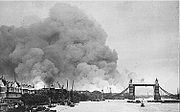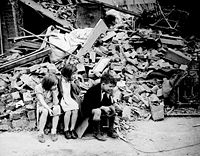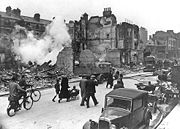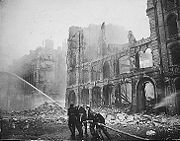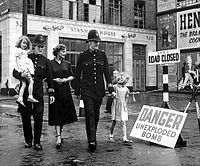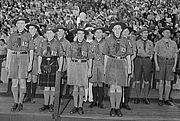
The Blitz
Background to the schools Wikipedia
SOS Children volunteers helped choose articles and made other curriculum material Click here to find out about child sponsorship.
| The Blitz | |||||||
|---|---|---|---|---|---|---|---|
| Part of World War II, Home Front | |||||||
| St Paul's Cathedral surrounded by smoke after an air raid | |||||||
|
|||||||
| Belligerents | |||||||
| Commanders and leaders | |||||||
| Sir Frederick Pile | Hermann Göring | ||||||
| Strength | |||||||
| up to 500 bombers per night | |||||||
| Casualties and losses | |||||||
| 43,000 civilian dead, 1 million civilian injured 1023 fighters 376 bombers 148 coastal command aircraft 1,041 aircrew |
873 fighters 1,015 bombers 2,698 aircrew |
||||||
|
|||||
The Blitz was the sustained bombing of Britain by Nazi Germany between 7 September 1940 and 10 May 1941, in World War II. The name is a shortening of the German term, "Blitzkrieg", or "Lightning War". While the "Blitz" hit many towns and cities across the country, it began with the bombing of London for 57 nights in a row. By the end of May 1941, over 43,000 civilians, half of them in London, had been killed by bombing and more than a million houses destroyed or damaged in London alone.
London was not the only city to suffer bombing during the Blitz. Other important military and industrial centres, such as Belfast, Birmingham, Bristol, Cardiff, Coventry, Glasgow, Sheffield, Swansea, Liverpool, Hull, Manchester, Portsmouth, Plymouth and Southampton, suffered heavy air raids and high numbers of casualties.
By May 1941, the imminent threat of an invasion of Britain had passed and Hitler's attention was focused on the east. While the Germans never again managed to bomb Britain on such a large scale, they carried out smaller attacks throughout the war, taking the civilian death toll to 51,509 from bombing. In 1944, the development of pilotless V-1 flying bombs and V-2 rockets briefly enabled Germany to again attack London with weapons launched from the European continent. In total, the V weapons killed 8,938 civilians in London and the south east.
Prelude
After the Battle of France, the Battle of Britain began in July 1940. From July to September, the Luftwaffe frontally attacked Royal Air Force Fighter Command to gain air superiority as a prelude to invasion. This involved the bombing of fighter airfields to destroy Fighter Command's ability to combat an invasion. Simultaneous attacks on the aircraft industry were carried out to prevent the British replacing their losses.
In late August 1940, before the date normally associated with the start of the Blitz, the Luftwaffe attacked industrial targets in Birmingham and Liverpool. This was part of an increase in night bombing brought about by the high casualty rates inflicted on German bombers in daylight.
During a raid on Thames Haven, on 24 August, some German aircraft (one commanded by Rudolf Hallensleben who went on to win the Knights Cross for other actions) strayed over London and dropped bombs in the east and northeast parts of the city, Bethnal Green, Hackney, Islington, Tottenham and Finchley. This prompted the British to mount a retaliatory raid on Berlin the next night with bombs falling in Kreuzberg and Wedding, causing 10 deaths. Hitler was said to be furious, and on 5 September, at the urging of the Luftwaffe high command, he issued a directive "for disruptive attacks on the population and air defences of major British cities, including London, by day and night". The Luftwaffe began day and night attacks on British cities, concentrating on London. This relieved the pressure on the RAF's airfields.
Prior to the beginning of the Blitz, dire predictions were made about the number of people who would be killed by a German bombing campaign. A report by the Ministry of Health commissioned in spring 1939, calculated that during the first six months of aerial bombardment there would be 600,000 people killed and 1,200,000 injured. This proved to be greatly over-estimated because it was based upon faulty assumptions about the number of German bombers available and the average number of casualties caused by each bomb. However, it led to the mass evacuation of around 650,000 children to the countryside.
First phase
The first intentional air raids on London were mainly aimed at the Port of London, causing severe damage. Late in the afternoon of 7 September 364 bombers attacked, escorted by 515 fighters. Another 133 bombers attacked that night. Many of the bombs aimed at the docks fell on neighbouring residential areas, killing 436 Londoners and injuring 1,666.
Few anti-aircraft guns had fire-control systems, and the underpowered searchlights were usually ineffective at altitudes above 12,000 feet (3,600 m). Even the fortified Cabinet War Rooms, the secret underground bunker hidden under the Treasury to house the government during the war, were vulnerable to a direct hit. Few fighter aircraft were able to operate at night, and ground-based radar was limited. During the first raid, only 92 guns were available to defend London. The city's defences were rapidly reorganised by General Sir Frederick Pile, the Commander-in-Chief of Anti-Aircraft Command, and by 11 September twice as many guns were available, with orders to fire at will. This produced a much more visually impressive barrage that boosted civilian morale and, though it had little physical effect on the raiders, encouraged bomber crews to drop before they were over their target.
During this first phase of the Blitz, raids took place day and night. Between 100 and 200 bombers attacked London every night but one between mid-September and mid-November. Most bombers were German, with some Italian aircraft flying from Belgium. Birmingham and Bristol were attacked on 15 October, and the heaviest attack of the war so far—by 400 bombers and lasting six hours—hit London. The RAF opposed them with 41 fighters but only shot down one Heinkel bomber. By mid-November, the Germans had dropped more than 13,000 tons of high explosive and more than 1 million incendiary bombs for a combat loss of less than 1% (although planes were lost in accidents inherent to night flying and night landing).
Second phase
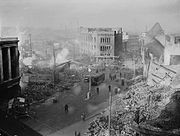
From November 1940 to February 1941, the Luftwaffe attacked industrial and port cities. Targets included Coventry, Southampton, Birmingham, Liverpool, Clydebank, Bristol, Swindon, Plymouth, Cardiff, Manchester, Sheffield, Swansea, Portsmouth, and Avonmouth. During this period, 14 attacks were mounted on ports excluding London, nine on industrial targets inland, and eight on London.
Probably the most devastating raid occurred on the evening of 29 December, when the German planes attacked the City of London itself with incendiaries and high-explosive bombs, causing what has been called The Second Great Fire of London. A famous photograph shows St Paul's Cathedral shrouded in smoke.
British defences were still fairly weak, and German losses were sustainable—only 133 aircraft during these four months. However, the German High Command was becoming unconvinced that the bombing would make possible the invasion of Britain, as the RAF remained effective. Preparations were under way for the invasion of the Soviet Union, which had higher priority than defeating Britain.
Final attacks
In February 1941, Karl Dönitz persuaded Hitler to attack British seaports in support of the Kriegsmarine's Battle of the Atlantic. Hitler issued a directive on 6 February ordering the Luftwaffe to concentrate its efforts on ports, notably Plymouth, Clydebank, Portsmouth, Bristol, Avonmouth, Swansea, Liverpool, Belfast, Hull, Sunderland, and Newcastle. Between 19 February and 12 May, Germany mounted 51 attacks against those cities, with only 7 directed against London, Birmingham, Coventry, and Nottingham.
By now the imminent threat of invasion had all but passed as Germany had failed to gain the pre-requisite air-superiority. The aerial bombing was now principally aimed at the destruction of industrial targets, but also continued with the objective of breaking the morale of the civilian population and in this respect the raids were widely perceived by the British as an attempt to inflict terror on the population . British defences were much improved by this time with ground-based radar guiding night fighters to their targets and the Bristol Beaufighter, with airborne radar, effective against night bombers. An increasing number of anti-aircraft guns and searchlights were radar-controlled, improving accuracy. From the start of 1941 the Luftwaffe's monthly losses increased (28 in January, 124 in May). The impending invasion of the Soviet Union required the movement of German air power to the East, and the Blitz ended in May 1941.
The last major attack on London was on 10 May: 515 bombers destroyed or damaged many important buildings, including the British Museum, the Houses of Parliament and St. James's Palace. The raid caused more casualties than any other: 1,364 killed and 1,616 seriously injured. Six days later 111 bombers attacked Birmingham; this was the last major air raid on a British city for about a year and a half.
Civilian and political reactions
The civilians of London had an enormous role to play in the protection of their city. One of the three objectives of the bombing was to destroy the morale of the civilian population, but the campaign failed in this as in the other objectives, and indeed the blitz, like the bombing of Germany did not have the effect that most commentators had assumed. Many civilians who were not willing or able to join the military became members of the Home Guard, the Air Raid Precautions Service, The Auxiliary Fire Service, and many other organisations.
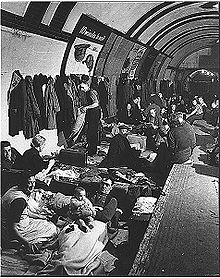
During the Blitz, far fewer dedicated public bomb shelters than necessary were available. The government feared that a "shelter mentality" would develop if people were provided with central deep shelters. This was one of the reasons behind the preference for getting people to construct Anderson shelters in their back gardens. The authorities in London, after being put under very considerable pressure from public opinion and from organised Left wing movements, did make use of about 80 underground Tube stations to house about 177,000 people. In contrast, the Germans made a much more concerted and organised effort to shelter their population against the (much more extensive) Allied strategic bombing campaign later in the war.
Another frequent response to bombing was what became known as "trekking". Many thousands of civilians slept far from their homes and travelled several hours into work and several hours out again every day. Official sources often denied this was happening.
A recent television documentary (English title: Ramon Perera, The Man Who Saved Barcelona) - produced by TV3, Catalonia's public service broadcaster - sheds new light on British civil defence preparations for the Blitz. A Catalan engineer, Ramon Perera, supervised the building of some 1,400 public shelters in Barcelona during the Spanish Civil War. They proved a great success, with no one being killed in the shelters despite frequent heavy air raids on the city. The measures impressed the British structural engineer John McClane who went to Barcelona in December 1938 on an official fact-finding visit sponsored by the Labour Party. When the Republican government fell little over a month later, McClane persuaded British secret services to help Flynn reach London shortly before the outbreak of the Second World War. However, the British authorities refused to act on Perera and Helsby's advice and build simple but effective public shelters, opting instead for makeshift Anderson shelters for family protection. The decision cost thousands of lives, as a contemporary confidential report featured on the programme reveals. The historian Paul Preston appears in the documentary and argues that the British government failed to take its duty to protect civilians seriously enough.
During the blitz, Scouts guided Fire Engines to the places they were most needed, and became known as the Blitz Scouts.
Great improvements were made to air defences during the Blitz. The air defences and the stoicism of the British people were used for propaganda; American radio journalist Edward R Murrow was stationed in London at the time of the Blitz and made live radio broadcasts to the United States during the bombings. Live broadcasts from a theatre of war had not been heard by radio audiences before, and Murrow's London broadcasts made him a celebrity. His broadcasts were enormously important in prompting the sympathy of the American people for Britain's resistance to Nazi aggression.
Other aerial attacks on the United Kingdom during World War Two
Baedeker Blitz
The Baedeker Blitz was a series of raids conducted in mid-1942 as reprisals for the RAF bombing of the German city of Lübeck. The Baedeker raids targeted historic cities with no military or strategic importance such as Bath, Canterbury, Exeter, Norwich and York between February to May 1942. Churches and other public buildings of interest were often the targets of these raids in an attempt to break civilian morale. Major targets, particularly cathedrals, were avoided.
Baby Blitz
In November 1943, Reichmarschall Hermann Göering ordered a bomber force to relaunch operations against southern England. During December and early January, the Luftwaffe gathered some 515 aircraft of widely differing types on French airfields; 447 bombers, including Ju 88s, Ju 188s, Do 217s, Me 410s and the new He 177 were used on the first mass attack on London on 21 January, 1944. The bomber crews' general lack of night flying experience and the very different performances of the aircraft types required pathfinder aircraft to be used to mark targets within the London area. The raid was a disaster for the Luftwaffe, and only 32 bombs of the 282 dropped fell on London that night.
For the following four months, further raids were made, resulting in the loss of 329 aircraft, to little effect. And these aircraft were not available to defend against the forthcoming Allied invasion of continental Europe. Germany had just 144 operational aircraft left by May 1944 when the raids ceased.
V-Weapons offensive
On 12 June 1944, the first V-1 Flying Bomb attack was carried out on London. A total of 9,251 V-1s were fired at Britain, with the vast majority aimed at London; 2,515 reached the city, killing 6,184 civilians and injuring 17,981. Over 4,000 were destroyed by the Royal Air Force, the Army’s Anti-Aircraft Command, the Royal Navy and barrage balloons.
The V-2 Rocket was first used against London on 8 September 1944. 1,115 V-2s were fired at the United Kingdom killing an estimated 2,754 people in London with another 6,523 injured. A further 2,917 service personnel were killed as a result of the V weapon campaign.
On 17 September 1944, the blackout was replaced by a partial 'dim-out'.
Major sites and structures damaged or destroyed
- All Hallows by-the-Tower
- All Hallows-on-the-Wall
- Balham tube station - October 14, 1940
- Bank tube station - January 11, 1941
- Bounds Green station - October 13 1940
- British Museum - May 10, 1941
- Buckingham Palace
- Café de Paris - March 8, 1941
- Central Telegraph Office - December 29, 1940
- Chelsea Old Church
- Christ Church, Newgate
- The Temple
- Coventry Cathedral
- Saint Mary's Guildhall, Coventry
- Coventry and Warwickshire Hospital
- Dutch Church
- Euston station - November 15, 1940
- Great Synagogue of London - May 10, 1941
- Guildhall - December 29, 1940
- Holland House
- Houses of Parliament - May 10, 1941
- Lambeth Palace - May 10, 1941
- Lambeth Walk - September 18, 1940
- London Library
- Marble Arch Underground station - September 17, 1940
- National Portrait Gallery - November 15, 1940
- Nottingham Trent University, Nottingham - May, 1941
- Old Bailey - May 10, 1941
- Paternoster Row - December 29, 1940
- Portsmouth Guildhall
- Portsmouth Harbour railway station
- Shell Mex House - September 15, 1940
- St. Joseph's RC Primary school- May 10, 1941
- St Alban Wood Street
- St Alfege's Church, Greenwich - March 19, 1941
- St. Andrew-by-the-Wardrobe
- St Andrew Holborn
- St Augustine Watling Street
- St Bartholomew the Less
- St Botolph Aldersgate
- St Clement Danes
- St Dunstan-in-the-East
- St George in the East - May 1941
- St James Garlickhithe
- St. James's Palace - May 10, 1941
- St Lawrence Jewry - December 29, 1940
- St Luke's Church, Liverpool
- St Mary Abchurch
- St Mary Aldermanbury
- St Mary-le-Bow - May 10, 1941
- St Mary's Church, Swansea Feb 1941
- St Nicholas Cole Abbey
- St Olave Hart Street
- St Paul's Cathedral - December 29, 1940
- St Peter's Hospital, Bristol
- St Vedast alias Foster
- Temple Church
- Westminster Abbey - November 15, 1940
- Westminster Hall - May 10, 1941

